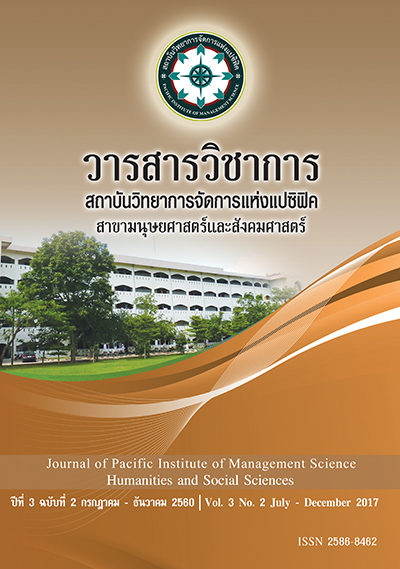The Development of Critical Reading Ability of Mathayomsuksa 3 Students Taught by SQ4R Teaching Method.
Keywords:
critical reading ability, SQ4R teaching method, การอ่านอย่างมีวิจารณญาณ, วิธีสอนแบบ SQ4RAbstract
The purposes of this research were to study : 1) develop critical reading ability of mathayomsuksa 3 students taught by SQ4R teaching method of pretest and posttest, and 2) study mathayomsuksa 3 students’ opinions towards learning taught by SQ4R teaching method. research methodology is The pre-experimental design was one group pretest-posttest design, population was mathayomsuksa 3 students of Rachineeburana School in Nakornpathom in second semester of 2016. sample size were 46 mathayomsuksa 3 students of Rachineeburana School in Nakornpathom. sampling method is Simple Random Sampling the research instruments were lesson plan of the critical reading ability of mathayomsuksa 3 students taught by SQ4R teaching method, comprehensive test for critical reading ability of mathayomsuksa 3 students taught by SQ4R teaching method and a questionare for mathayomsuksa 3 students taught by SQ4R teaching method The data were analyzed by used IOC, dificulty, reliability, pretest-posttest of critical reading ability and mathayomsuksa 3 students’ opinions towards learning taught by SQ4R teaching method. The statistics used in data analysis by mean (x), standard deviation (s.d.) and t-test dependent.
The results were as follows:
1.The posttest critical reading ability of mathayomsuksa 3 students taught by SQ4R teaching method was higher than the pretest, there was statistically signiicant at .05 level.
2.The mathayomsuksa 3 students’ opinions towards learning taught by SQ4R teaching method were at high level.
References
กานต์ธิดา แก้วกาม. (2556). การเปรียบเทียบผลสัมฤทธิ์การอ่านจับใจความของนักเรียนชั้นมัธยมศึกษาปีที่ 1 ที่จัดการเรียนรู้โดยวิธีสอนแบบ SQ4R กับวิธีสอนแบบปกติ. วิทยานิพันธุ์ภาควิชาหลักสูตรและวิธีสอน บณัฑติวิทยาลัยมหาวิทยาลัยศิลปากร.
ดนยา วงศ์ธนะชัย. (2542). การอ่านเพื่อชีวิต. ลพบุรี : สถาบันราชภัฏพิบูลสงคราม.
ณภัทร เทพพรรธนะ. (2541). ภาษาไทยเพื่อการสื่อสาร.กรุงเทพมหานคร.ดอกหญ้า นภดล จันทร์เพ็ญ. (2535). การใช้ภาษาไทย.กรุงเทพมหานคร : แสงศิลป์การพิมพ์ .
เมขลา ลือโสภา. (2555). การพัฒนาการอ่านจับใจความด้วยวิธีการสอนแบบ SQ4R กลุ่มสาระการเรียนรู้ภาษาไทย
ชั้นมัธยมศึกษาปีที่ 1. มหาสารคาม : มหาวิทยาลัยราชภัฏมหาสารคาม.
มาลัย ทองสิมา. (2559). ครูชำนาญการพิเศษโรงเรียนราชินีบูรณะ, สัมภาษณ์ 20 พฤษภาคม.
รัตนภัณฑ์เลิศคาฟู. (2547). การใช้วิธีสอบแบบเอสควิโฟร์อาร์ในการสอนอ่านจับใจความสำคัญสำหรับนักเรียนชั้นประถม ศึกษาปีที่ 5. เชียงใหม่ : มหาวิทยาลัยเชียงใหม่.
วิภา อมรศิริอาภรณ์ . (2558). ครูชำนาญการโรงเรียนราชินีบูรณะ, สัมภาษณ์ 20 พฤษภาคม.
วรรณี คำเจริญ. (2558). ครูชำนาญการพิเศษโรงเรียนราชินีบูรณะ, สัมภาษณ์ 11 สิงหาคม.
ศุภิษฐา เจียรกุล. (2546). คู่มือการสอนอย่างมีประสิทธิภาพ. กรุงเทพมหานคร : โรงพิมพ์มหาวิทยาลัยธรรมศาสตร์ .
สุคนธ์ สินธพานนท์ และคณะ. (2552). พัฒนาทักษะการคิด...พิชิตการสอน. พิมพ์ครั้งที่ 4 กรุงเทพมหานคร
โรงพิมพ์เลี่ยงเชียง.
สุนันทา มั่นเศรษฐีวิทย์ . (2535). การสอนอ่านวิชาภาษาไทย.กรุงเทพมหานคร : ภาควิชาการศึกษา คณะศึกษาศาสตร์มหาวิทยาลัยเกษตรศาสตร์ .
สุวัฒน์ วิวัฒนานนท์ . (2550). ทักษะการอ่าน คิดวิเคราะห์ และเขียน. นนทบุรี ซี.ซี. นอลลิดจ์ ลิงคส์ .
Ghaith, G.M., Shaaban K.A., and Halal N.A. (2005). The relative effectiveness of prereading strategies on the comprehension of ELS readers. Available at https://wwwlb.aub.edu.lb~webpubof/ research/21report/education_pr ojects.html.
Heilman, A.W.(1967). Principle and Practices of Teaching Reading. Ohio: A Bell&Howell.
Miner,W. 2005. The impact of the SQ4R, as a strategy for retelling expository text, on student comprehension. Retrieved from https://www.src. Truman.edu
Rubin, D. (1990). A Practical Approach to Teaching Reading. New York: Schuster.
Wander & Cooper.1996. To What and How of Reading Instruction. (2nd ed ). Ohio:Meritt Publishing Company.
Downloads
Published
Issue
Section
License
บทความที่ได้รับการตีพิมพ์เป็นลิขสิทธิ์ของ สถาบันวิทยาการจัดการแห่งแปซิฟิค
ข้อความที่ปรากฏในบทความแต่ละเรื่องในวารสารวิชาการเล่มนี้เป็นความคิดเห็นส่วนตัวของผู้เขียนแต่ละท่านไม่เกี่ยวข้องกับสถาบันวิทยาการจัดการแห่งแปซิฟิค และคณาจารย์ท่านอื่นๆในสถาบันฯ แต่อย่างใด ความรับผิดชอบองค์ประกอบทั้งหมดของบทความแต่ละเรื่องเป็นของผู้เขียนแต่ละท่าน หากมีความผิดพลาดใดๆ ผู้เขียนแต่ละท่านจะรับผิดชอบบทความของตนเองแต่ผู้เดียว







